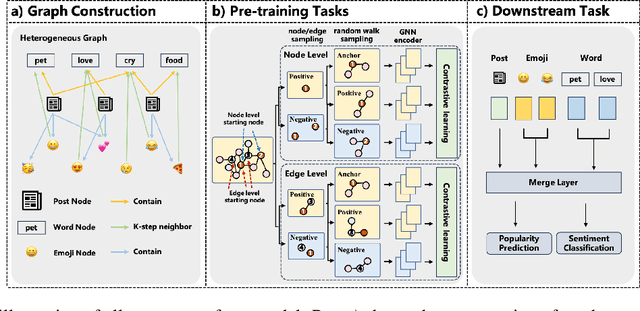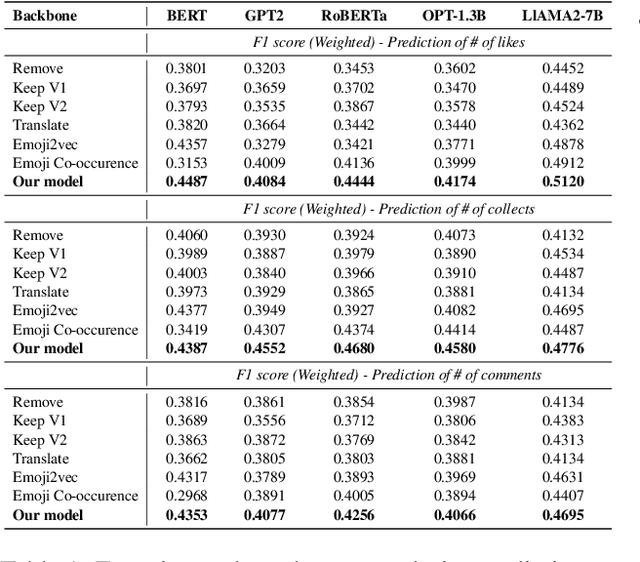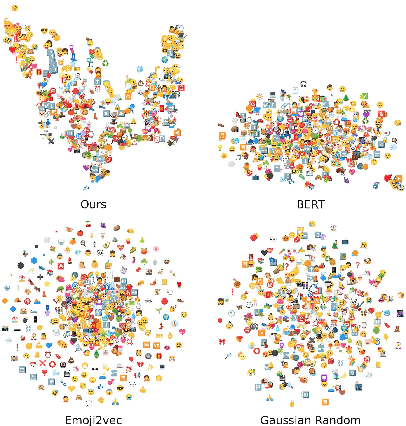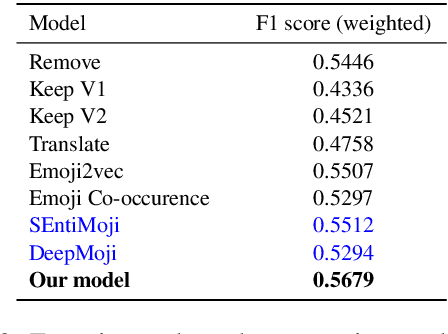Jiarong Xu
Unifying Text Semantics and Graph Structures for Temporal Text-attributed Graphs with Large Language Models
Mar 18, 2025Abstract:Temporal graph neural networks (TGNNs) have shown remarkable performance in temporal graph modeling. However, real-world temporal graphs often possess rich textual information, giving rise to temporal text-attributed graphs (TTAGs). Such combination of dynamic text semantics and evolving graph structures introduces heightened complexity. Existing TGNNs embed texts statically and rely heavily on encoding mechanisms that biasedly prioritize structural information, overlooking the temporal evolution of text semantics and the essential interplay between semantics and structures for synergistic reinforcement. To tackle these issues, we present \textbf{{Cross}}, a novel framework that seamlessly extends existing TGNNs for TTAG modeling. The key idea is to employ the advanced large language models (LLMs) to extract the dynamic semantics in text space and then generate expressive representations unifying both semantics and structures. Specifically, we propose a Temporal Semantics Extractor in the {Cross} framework, which empowers the LLM to offer the temporal semantic understanding of node's evolving contexts of textual neighborhoods, facilitating semantic dynamics. Subsequently, we introduce the Semantic-structural Co-encoder, which collaborates with the above Extractor for synthesizing illuminating representations by jointly considering both semantic and structural information while encouraging their mutual reinforcement. Extensive experimental results on four public datasets and one practical industrial dataset demonstrate {Cross}'s significant effectiveness and robustness.
Boosting Diffusion-Based Text Image Super-Resolution Model Towards Generalized Real-World Scenarios
Mar 11, 2025Abstract:Restoring low-resolution text images presents a significant challenge, as it requires maintaining both the fidelity and stylistic realism of the text in restored images. Existing text image restoration methods often fall short in hard situations, as the traditional super-resolution models cannot guarantee clarity, while diffusion-based methods fail to maintain fidelity. In this paper, we introduce a novel framework aimed at improving the generalization ability of diffusion models for text image super-resolution (SR), especially promoting fidelity. First, we propose a progressive data sampling strategy that incorporates diverse image types at different stages of training, stabilizing the convergence and improving the generalization. For the network architecture, we leverage a pre-trained SR prior to provide robust spatial reasoning capabilities, enhancing the model's ability to preserve textual information. Additionally, we employ a cross-attention mechanism to better integrate textual priors. To further reduce errors in textual priors, we utilize confidence scores to dynamically adjust the importance of textual features during training. Extensive experiments on real-world datasets demonstrate that our approach not only produces text images with more realistic visual appearances but also improves the accuracy of text structure.
Can Graph Neural Networks Expose Training Data Properties? An Efficient Risk Assessment Approach
Nov 06, 2024Abstract:Graph neural networks (GNNs) have attracted considerable attention due to their diverse applications. However, the scarcity and quality limitations of graph data present challenges to their training process in practical settings. To facilitate the development of effective GNNs, companies and researchers often seek external collaboration. Yet, directly sharing data raises privacy concerns, motivating data owners to train GNNs on their private graphs and share the trained models. Unfortunately, these models may still inadvertently disclose sensitive properties of their training graphs (e.g., average default rate in a transaction network), leading to severe consequences for data owners. In this work, we study graph property inference attack to identify the risk of sensitive property information leakage from shared models. Existing approaches typically train numerous shadow models for developing such attack, which is computationally intensive and impractical. To address this issue, we propose an efficient graph property inference attack by leveraging model approximation techniques. Our method only requires training a small set of models on graphs, while generating a sufficient number of approximated shadow models for attacks. To enhance diversity while reducing errors in the approximated models, we apply edit distance to quantify the diversity within a group of approximated models and introduce a theoretically guaranteed criterion to evaluate each model's error. Subsequently, we propose a novel selection mechanism to ensure that the retained approximated models achieve high diversity and low error. Extensive experiments across six real-world scenarios demonstrate our method's substantial improvement, with average increases of 2.7% in attack accuracy and 4.1% in ROC-AUC, while being 6.5$\times$ faster compared to the best baseline.
Unleashing the Power of Emojis in Texts via Self-supervised Graph Pre-Training
Sep 26, 2024



Abstract:Emojis have gained immense popularity on social platforms, serving as a common means to supplement or replace text. However, existing data mining approaches generally either completely ignore or simply treat emojis as ordinary Unicode characters, which may limit the model's ability to grasp the rich semantic information in emojis and the interaction between emojis and texts. Thus, it is necessary to release the emoji's power in social media data mining. To this end, we first construct a heterogeneous graph consisting of three types of nodes, i.e. post, word and emoji nodes to improve the representation of different elements in posts. The edges are also well-defined to model how these three elements interact with each other. To facilitate the sharing of information among post, word and emoji nodes, we propose a graph pre-train framework for text and emoji co-modeling, which contains two graph pre-training tasks: node-level graph contrastive learning and edge-level link reconstruction learning. Extensive experiments on the Xiaohongshu and Twitter datasets with two types of downstream tasks demonstrate that our approach proves significant improvement over previous strong baseline methods.
Can Modifying Data Address Graph Domain Adaptation?
Jul 27, 2024



Abstract:Graph neural networks (GNNs) have demonstrated remarkable success in numerous graph analytical tasks. Yet, their effectiveness is often compromised in real-world scenarios due to distribution shifts, limiting their capacity for knowledge transfer across changing environments or domains. Recently, Unsupervised Graph Domain Adaptation (UGDA) has been introduced to resolve this issue. UGDA aims to facilitate knowledge transfer from a labeled source graph to an unlabeled target graph. Current UGDA efforts primarily focus on model-centric methods, such as employing domain invariant learning strategies and designing model architectures. However, our critical examination reveals the limitations inherent to these model-centric methods, while a data-centric method allowed to modify the source graph provably demonstrates considerable potential. This insight motivates us to explore UGDA from a data-centric perspective. By revisiting the theoretical generalization bound for UGDA, we identify two data-centric principles for UGDA: alignment principle and rescaling principle. Guided by these principles, we propose GraphAlign, a novel UGDA method that generates a small yet transferable graph. By exclusively training a GNN on this new graph with classic Empirical Risk Minimization (ERM), GraphAlign attains exceptional performance on the target graph. Extensive experiments under various transfer scenarios demonstrate the GraphAlign outperforms the best baselines by an average of 2.16%, training on the generated graph as small as 0.25~1% of the original training graph.
Unveiling Privacy Vulnerabilities: Investigating the Role of Structure in Graph Data
Jul 26, 2024Abstract:The public sharing of user information opens the door for adversaries to infer private data, leading to privacy breaches and facilitating malicious activities. While numerous studies have concentrated on privacy leakage via public user attributes, the threats associated with the exposure of user relationships, particularly through network structure, are often neglected. This study aims to fill this critical gap by advancing the understanding and protection against privacy risks emanating from network structure, moving beyond direct connections with neighbors to include the broader implications of indirect network structural patterns. To achieve this, we first investigate the problem of Graph Privacy Leakage via Structure (GPS), and introduce a novel measure, the Generalized Homophily Ratio, to quantify the various mechanisms contributing to privacy breach risks in GPS. Based on this insight, we develop a novel graph private attribute inference attack, which acts as a pivotal tool for evaluating the potential for privacy leakage through network structures under worst-case scenarios. To protect users' private data from such vulnerabilities, we propose a graph data publishing method incorporating a learnable graph sampling technique, effectively transforming the original graph into a privacy-preserving version. Extensive experiments demonstrate that our attack model poses a significant threat to user privacy, and our graph data publishing method successfully achieves the optimal privacy-utility trade-off compared to baselines.
LOGIN: A Large Language Model Consulted Graph Neural Network Training Framework
May 22, 2024



Abstract:Recent prevailing works on graph machine learning typically follow a similar methodology that involves designing advanced variants of graph neural networks (GNNs) to maintain the superior performance of GNNs on different graphs. In this paper, we aim to streamline the GNN design process and leverage the advantages of Large Language Models (LLMs) to improve the performance of GNNs on downstream tasks. We formulate a new paradigm, coined "LLMs-as-Consultants," which integrates LLMs with GNNs in an interactive manner. A framework named LOGIN (LLM Consulted GNN training) is instantiated, empowering the interactive utilization of LLMs within the GNN training process. First, we attentively craft concise prompts for spotted nodes, carrying comprehensive semantic and topological information, and serving as input to LLMs. Second, we refine GNNs by devising a complementary coping mechanism that utilizes the responses from LLMs, depending on their correctness. We empirically evaluate the effectiveness of LOGIN on node classification tasks across both homophilic and heterophilic graphs. The results illustrate that even basic GNN architectures, when employed within the proposed LLMs-as-Consultants paradigm, can achieve comparable performance to advanced GNNs with intricate designs. Our codes are available at https://github.com/QiaoYRan/LOGIN.
CT-Eval: Benchmarking Chinese Text-to-Table Performance in Large Language Models
May 20, 2024Abstract:Text-to-Table aims to generate structured tables to convey the key information from unstructured documents. Existing text-to-table datasets are typically oriented English, limiting the research in non-English languages. Meanwhile, the emergence of large language models (LLMs) has shown great success as general task solvers in multi-lingual settings (e.g., ChatGPT), theoretically enabling text-to-table in other languages. In this paper, we propose a Chinese text-to-table dataset, CT-Eval, to benchmark LLMs on this task. Our preliminary analysis of English text-to-table datasets highlights two key factors for dataset construction: data diversity and data hallucination. Inspired by this, the CT-Eval dataset selects a popular Chinese multidisciplinary online encyclopedia as the source and covers 28 domains to ensure data diversity. To minimize data hallucination, we first train an LLM to judge and filter out the task samples with hallucination, then employ human annotators to clean the hallucinations in the validation and testing sets. After this process, CT-Eval contains 88.6K task samples. Using CT-Eval, we evaluate the performance of open-source and closed-source LLMs. Our results reveal that zero-shot LLMs (including GPT-4) still have a significant performance gap compared with human judgment. Furthermore, after fine-tuning, open-source LLMs can significantly improve their text-to-table ability, outperforming GPT-4 by a large margin. In short, CT-Eval not only helps researchers evaluate and quickly understand the Chinese text-to-table ability of existing LLMs but also serves as a valuable resource to significantly improve the text-to-table performance of LLMs.
Towards Fair Graph Federated Learning via Incentive Mechanisms
Dec 20, 2023Abstract:Graph federated learning (FL) has emerged as a pivotal paradigm enabling multiple agents to collaboratively train a graph model while preserving local data privacy. Yet, current efforts overlook a key issue: agents are self-interested and would hesitant to share data without fair and satisfactory incentives. This paper is the first endeavor to address this issue by studying the incentive mechanism for graph federated learning. We identify a unique phenomenon in graph federated learning: the presence of agents posing potential harm to the federation and agents contributing with delays. This stands in contrast to previous FL incentive mechanisms that assume all agents contribute positively and in a timely manner. In view of this, this paper presents a novel incentive mechanism tailored for fair graph federated learning, integrating incentives derived from both model gradient and payoff. To achieve this, we first introduce an agent valuation function aimed at quantifying agent contributions through the introduction of two criteria: gradient alignment and graph diversity. Moreover, due to the high heterogeneity in graph federated learning, striking a balance between accuracy and fairness becomes particularly crucial. We introduce motif prototypes to enhance accuracy, communicated between the server and agents, enhancing global model aggregation and aiding agents in local model optimization. Extensive experiments show that our model achieves the best trade-off between accuracy and the fairness of model gradient, as well as superior payoff fairness.
Better with Less: A Data-Active Perspective on Pre-Training Graph Neural Networks
Nov 21, 2023Abstract:Pre-training on graph neural networks (GNNs) aims to learn transferable knowledge for downstream tasks with unlabeled data, and it has recently become an active research area. The success of graph pre-training models is often attributed to the massive amount of input data. In this paper, however, we identify the curse of big data phenomenon in graph pre-training: more training data do not necessarily lead to better downstream performance. Motivated by this observation, we propose a better-with-less framework for graph pre-training: fewer, but carefully chosen data are fed into a GNN model to enhance pre-training. The proposed pre-training pipeline is called the data-active graph pre-training (APT) framework, and is composed of a graph selector and a pre-training model. The graph selector chooses the most representative and instructive data points based on the inherent properties of graphs as well as predictive uncertainty. The proposed predictive uncertainty, as feedback from the pre-training model, measures the confidence level of the model in the data. When fed with the chosen data, on the other hand, the pre-training model grasps an initial understanding of the new, unseen data, and at the same time attempts to remember the knowledge learned from previous data. Therefore, the integration and interaction between these two components form a unified framework (APT), in which graph pre-training is performed in a progressive and iterative way. Experiment results show that the proposed APT is able to obtain an efficient pre-training model with fewer training data and better downstream performance.
 Add to Chrome
Add to Chrome Add to Firefox
Add to Firefox Add to Edge
Add to Edge